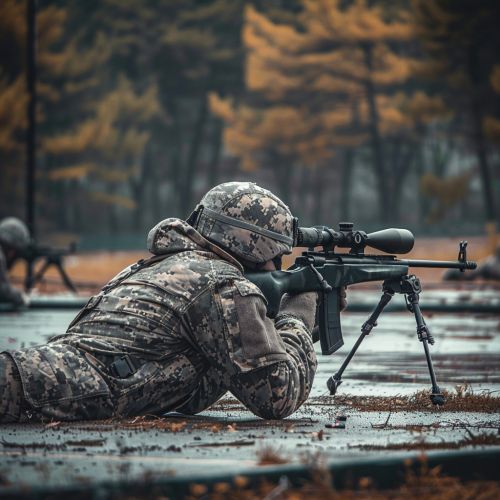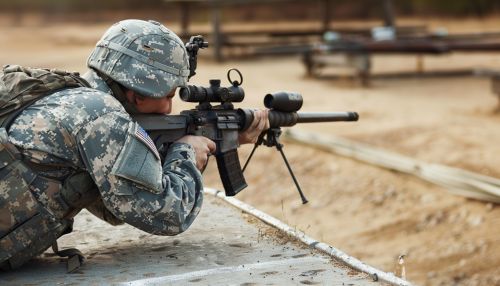Military Marksmanship
Introduction
Military marksmanship is the skill of accurately and effectively using firearms in a military context. This discipline encompasses a wide range of techniques and principles that are essential for soldiers to master in order to engage targets accurately and efficiently under various conditions. Military marksmanship is a critical component of military training and operations, as it directly impacts the effectiveness and survivability of soldiers in combat situations.
Historical Overview
The history of military marksmanship dates back to the early use of projectile weapons in warfare. The evolution of firearms, from early muskets to modern rifles, has significantly influenced the development of marksmanship techniques. In the 18th and 19th centuries, the introduction of rifled barrels and more accurate ammunition led to the establishment of formal marksmanship training programs in many military forces. The American Civil War and the Napoleonic Wars were pivotal periods that highlighted the importance of accurate shooting in battle.
Principles of Marksmanship
The principles of military marksmanship are fundamental guidelines that soldiers must follow to achieve accuracy and precision. These principles include:
Position and Stability
A stable shooting position is crucial for accuracy. The four primary shooting positions are prone, kneeling, sitting, and standing. Each position offers different levels of stability and mobility, and soldiers are trained to use the appropriate position based on the tactical situation.
Sight Alignment and Sight Picture
Sight alignment refers to the proper alignment of the firearm's sights with the target. Sight picture is the visual relationship between the aligned sights and the target. Consistent sight alignment and sight picture are essential for accurate shooting.
Trigger Control
Trigger control involves the smooth and deliberate squeezing of the trigger without disturbing the sight alignment. Proper trigger control minimizes the movement of the firearm and ensures that the shot is fired accurately.
Breathing Control
Breathing control is the practice of timing the shot with the natural respiratory pause. This pause occurs at the end of exhalation, providing a moment of minimal body movement, which is ideal for taking the shot.
Follow-Through
Follow-through is the continuation of the shooting process after the shot is fired. It involves maintaining the sight picture and trigger control until the bullet exits the barrel. Proper follow-through ensures that the shooter does not anticipate the shot and disrupt the firearm's stability.
Marksmanship Training
Military marksmanship training is a comprehensive program designed to develop and refine the shooting skills of soldiers. Training typically includes classroom instruction, dry-fire practice, live-fire exercises, and simulated combat scenarios.
Basic Marksmanship Training
Basic marksmanship training focuses on teaching the fundamental principles and techniques of shooting. Soldiers learn to handle their firearms safely, maintain proper shooting positions, and apply the principles of marksmanship. This phase of training often includes extensive dry-fire practice to develop muscle memory and familiarity with the firearm.
Advanced Marksmanship Training
Advanced marksmanship training builds on the skills learned in basic training and introduces more complex shooting scenarios. Soldiers practice shooting at moving targets, engaging multiple targets, and shooting from unconventional positions. This phase of training also includes night shooting and the use of advanced optics and aiming devices.
Combat Marksmanship
Combat marksmanship training prepares soldiers for the realities of combat. This training emphasizes shooting under stress, rapid target acquisition, and shooting while moving. Soldiers practice engaging targets in urban environments, from vehicles, and in other tactical situations. The goal is to develop the ability to shoot accurately and effectively in high-pressure situations.
Marksmanship Competitions
Marksmanship competitions are an important aspect of military training and tradition. These competitions provide soldiers with the opportunity to test their skills against their peers and improve their shooting abilities. Competitions often include a variety of events, such as precision shooting, rapid-fire drills, and tactical scenarios.
International Competitions
International marksmanship competitions, such as the International Shooting Sport Federation (ISSF) events, bring together military and civilian shooters from around the world. These competitions promote the exchange of techniques and foster camaraderie among participants.
National Competitions
Many countries host national marksmanship competitions for their military personnel. These events often serve as a means of selecting the best shooters for international competitions and special assignments.
Equipment and Technology
The equipment and technology used in military marksmanship have evolved significantly over time. Modern firearms, optics, and accessories enhance the accuracy and effectiveness of soldiers in combat.
Firearms
The primary firearm used in military marksmanship is the rifle. Modern military rifles, such as the M16 and AK-47, are designed for accuracy, reliability, and versatility. Sniper rifles, such as the M24 and Barrett M82, are used for long-range precision shooting.
Optics
Optical sights, such as red dot sights and telescopic sights, improve target acquisition and accuracy. These devices provide a clear and magnified view of the target, allowing soldiers to aim more precisely.
Ammunition
The type of ammunition used can significantly impact accuracy and performance. Military ammunition is designed for reliability and consistency. Specialized ammunition, such as armor-piercing and tracer rounds, is used for specific tactical purposes.
Accessories
Various accessories, such as bipods, suppressors, and slings, enhance the functionality and versatility of firearms. These accessories help stabilize the firearm, reduce recoil, and improve the shooter's ability to engage targets effectively.


Psychological Aspects
The psychological aspects of military marksmanship are critical to a soldier's performance. Mental discipline, focus, and stress management are essential components of effective shooting.
Mental Discipline
Mental discipline involves maintaining concentration and composure under pressure. Soldiers must develop the ability to block out distractions and remain focused on the task at hand.
Stress Management
Combat situations are inherently stressful, and the ability to manage stress is crucial for accurate shooting. Techniques such as controlled breathing, visualization, and mental rehearsal help soldiers stay calm and focused.
Situational Awareness
Situational awareness is the ability to perceive and understand the environment and potential threats. Soldiers must be able to quickly assess the situation and make informed decisions about when and how to engage targets.
Marksmanship in Modern Warfare
Marksmanship continues to play a vital role in modern warfare. Advances in technology and tactics have changed the nature of combat, but the fundamental principles of marksmanship remain relevant.
Urban Warfare
Urban warfare presents unique challenges for marksmanship. Soldiers must be able to engage targets at close range, often in confined spaces and complex environments. The ability to shoot accurately and quickly is essential for success in urban combat.
Counterinsurgency Operations
Counterinsurgency operations require soldiers to distinguish between combatants and non-combatants. Precision shooting is critical to minimizing collateral damage and achieving mission objectives.
Special Operations
Special operations forces, such as Navy SEALs and Delta Force, rely heavily on marksmanship skills. These units often conduct high-risk missions that require precise and effective shooting.
Marksmanship Schools and Programs
Many military organizations have established specialized schools and programs to train and certify marksmen. These institutions provide advanced training and develop marksmanship instructors.
United States Army Marksmanship Unit (USAMU)
The United States Army Marksmanship Unit (USAMU) is a world-renowned organization dedicated to marksmanship training and competition. The USAMU conducts training for soldiers, develops marksmanship doctrine, and represents the Army in national and international competitions.
Sniper Schools
Sniper schools, such as the United States Marine Corps Scout Sniper School and the British Army Sniper School, provide specialized training for snipers. These programs focus on long-range shooting, target identification, and fieldcraft skills.
International Training Programs
Many countries offer international training programs to share marksmanship techniques and foster cooperation. These programs often include joint exercises, instructor exchanges, and collaborative research.
Future of Military Marksmanship
The future of military marksmanship will be shaped by advances in technology, training methods, and tactical doctrine. Emerging technologies, such as smart weapons and augmented reality, have the potential to revolutionize marksmanship.
Technological Innovations
Innovations in firearms, optics, and ammunition will continue to enhance the accuracy and effectiveness of soldiers. Developments in laser-guided weapons and smart optics are expected to provide significant advantages on the battlefield.
Training Methods
Advances in training methods, such as virtual reality and simulated training environments, will provide soldiers with more realistic and effective training experiences. These technologies allow for safe and cost-effective training in a variety of scenarios.
Tactical Doctrine
The evolution of tactical doctrine will influence the role of marksmanship in military operations. As new threats and challenges emerge, military organizations will adapt their marksmanship training and techniques to meet these demands.
Conclusion
Military marksmanship is a critical skill that underpins the effectiveness of soldiers in combat. The principles, training, and technology associated with marksmanship have evolved over time, but the fundamental importance of accurate shooting remains constant. As warfare continues to change, the discipline of military marksmanship will adapt and advance to meet new challenges.
